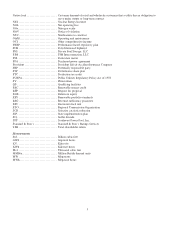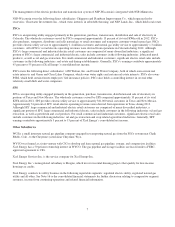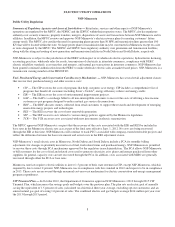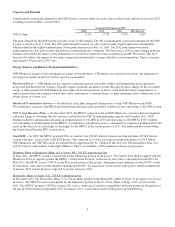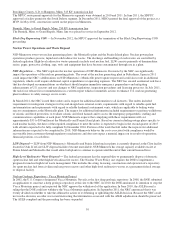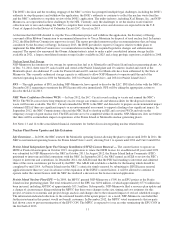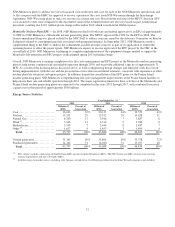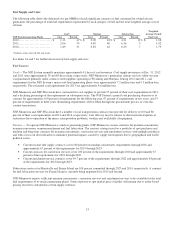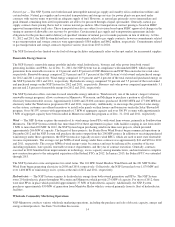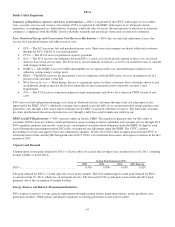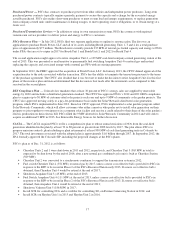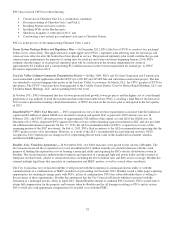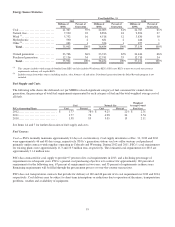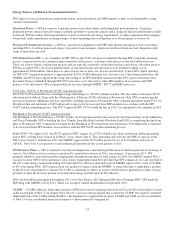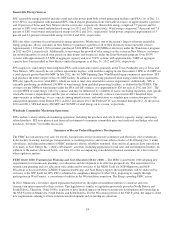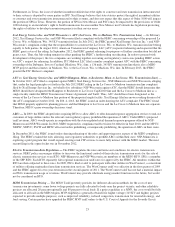Xcel Energy 2012 Annual Report Download - page 25
Download and view the complete annual report
Please find page 25 of the 2012 Xcel Energy annual report below. You can navigate through the pages in the report by either clicking on the pages listed below, or by using the keyword search tool below to find specific information within the annual report.15
NSP-Wisconsin
Public Utility Regulation
Summary of Regulatory Agencies and Areas of Jurisdiction — Retail rates, services and other aspects of NSP-Wisconsin’s
operations are regulated by the PSCW and the MPSC, within their respective states. In addition, each of the state commissions
certifies the need for new generating plants and electric transmission lines before the facilities may be sited and built. NSP-
Wisconsin is subject to the jurisdiction of the FERC with respect to its wholesale electric operations, hydroelectric generation
licensing, accounting practices, wholesale sales for resale, the transmission of electricity in interstate commerce, compliance with
the NERC electric reliability standards, asset transactions and mergers, and natural gas transactions in interstate commerce. NSP-
Wisconsin and NSP-Minnesota have been granted continued joint authorization from the FERC to make wholesale electric sales
at market-based prices. NSP-Wisconsin is a transmission owning member of the MISO RTO.
The PSCW has a biennial base rate filing requirement. By June of each odd numbered year, NSP-Wisconsin must submit a rate
filing for the test year beginning the following January.
Fuel and Purchased Energy Cost Recovery Mechanisms — NSP-Wisconsin does not have an automatic electric fuel adjustment
clause for Wisconsin retail customers. Instead, under Wisconsin rules, utilities submit a forward-looking annual fuel cost plan to
the PSCW for approval. Once the PSCW approves the fuel cost plan, utilities defer the amount of any fuel cost over-collection or
under-collection in excess of a two percent annual tolerance band, for future rate recovery or refund. Approval of a fuel cost plan
and any rate adjustment for refund or recovery of deferred costs is determined by the PSCW after an opportunity for a hearing.
Rate recovery of deferred fuel cost is subject to an earnings test based on the utility’s most recently authorized ROE.
NSP-Wisconsin’s wholesale electric rate schedules include a FCA to provide for adjustments to billings and revenues for changes
in the cost of fuel and purchased energy. Effective Jan. 1, 2013, NSP-Wisconsin no longer serves any wholesale municipal
electric customers. Rates for wholesale municipal services provided in 2012 will be subject to a formula rate true-up in 2013.
NSP-Wisconsin’s retail electric rate schedules for Michigan customers include power supply cost recovery factors, which are
based on 12-month projections. After each 12-month period, a reconciliation is submitted whereby over-collections are refunded
and any under-collections are collected from the customers over the subsequent 12-month period.
Wisconsin Energy Efficiency and Conservation Goals — In June 2011, the Wisconsin biennial budget bill was signed into law,
which rolled back the projected increases for state energy efficiency and conservation funding effective in 2012. Based on this
action, NSP-Wisconsin was allocated approximately $8.1 million of the statewide program costs in 2012. This amount is expected
to increase to approximately $8.6 million by 2014. Historically, NSP-Wisconsin has recovered these costs in rates charged to
Wisconsin retail customers and expects to recover the program costs in rates going forward.
Capacity and Demand
NSP-Wisconsin operates an integrated system with NSP-Minnesota. See NSP-Minnesota Capacity and Demand.
Energy Sources and Related Transmission Initiatives
NSP-Wisconsin operates an integrated system with NSP-Minnesota. See NSP-Minnesota Energy Sources and Related
Transmission Initiatives.
NSP-Wisconsin CapX2020 CPCN — The PSCW issued a CPCN for the Wisconsin portion of the CapX2020 Hampton, Minn. to
Rochester, Minn. to La Crosse, Wis. 345 KV project in May 2012. The Wisconsin portion consists of approximately 50 miles of
new transmission line. The PSCW also approved a route permit and the cost is estimated at $211 million. Subsequent legal
challenges to the PSCW’s order by intervenors were unsuccessful, thereby rendering the PSCW’s order final. Construction on the
Wisconsin portion of the line is anticipated to begin in 2014 and the line is expected to go into service in 2015.
Fuel Supply and Costs
NSP-Wisconsin operates an integrated system with NSP-Minnesota. See NSP-Minnesota Fuel Supply and Costs.


